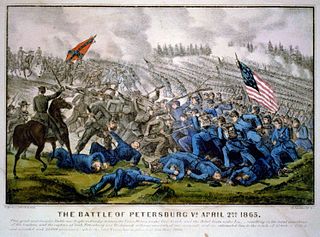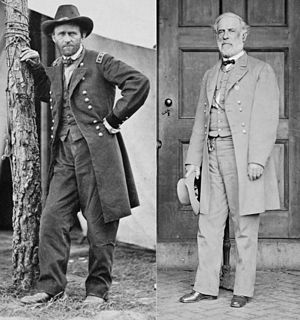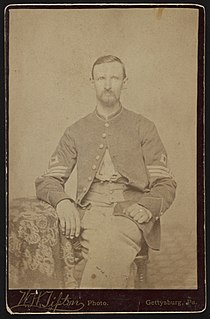
The Third Battle of Petersburg, also known as the Breakthrough at Petersburg or the Fall of Petersburg, was fought on April 2, 1865, south and southwest of Petersburg, Virginia, at the end of the 292-day Richmond–Petersburg Campaign and in the beginning stage of the Appomattox Campaign near the conclusion of the American Civil War. The Union Army under the overall command of General-in-Chief Lieutenant General Ulysses S. Grant, launched an assault on General Robert E. Lee's Confederate Army of Northern Virginia's Petersburg, Virginia trenches and fortifications after the Union victory at the Battle of Five Forks on April 1, 1865. As a result of that battle the Confederate right flank and rear were exposed. The remaining supply lines were cut and the Confederate defenders were reduced by over 10,000 men killed, wounded, taken prisoner or in flight.

The Appomattox campaign was a series of American Civil War battles fought March 29 – April 9, 1865, in Virginia that concluded with the surrender of Confederate General Robert E. Lee's Army of Northern Virginia to forces of the Union Army under the overall command of Lieutenant General Ulysses S. Grant, marking the effective end of the war.
The 23rd Pennsylvania Volunteer Infantry was an infantry regiment that fought in the Union Army during the American Civil War. Known for its colorful uniforms based upon the popular French Zouave style, the regiment served in the Eastern Theater.
The 11th Maine Infantry Regiment was an infantry regiment that served in the Union Army during the American Civil War.

The 205th Pennsylvania Infantry was an infantry regiment of the Union Army during the American Civil War. It was raised during the final war year in response to President Lincoln's call for 500,000 volunteers. The regiment joined the IX Corps to counter General Lee's final offensive thrust at Ford Stedman and attacked to break through the Petersburg defenses one week before his final surrender at Appomattox. It participated in the Grand Review of the Armies and was mustered out in June 1865.

The 138th Regiment, Pennsylvania Volunteer Infantry was an infantry regiment that served in the Union Army during the American Civil War.

The 62nd Ohio Infantry Regiment was an infantry regiment in the Union Army during the American Civil War.

The 116th Ohio Volunteer Infantry was an infantry regiment in the Union Army during the American Civil War.
The 8th United States Colored Infantry was an infantry regiment that served in the Union Army during the American Civil War. The regiment was composed of African American enlisted men commanded by white officers and was authorized by the Bureau of Colored Troops which was created by the United States War Department on May 22, 1863.
The 88th Regiment, Pennsylvania Volunteer Infantry was an infantry regiment that served in the Union Army during the American Civil War.
The 56th Pennsylvania Volunteer Infantry was an infantry regiment that served in the Union Army during the American Civil War. The unit has the distinction of being the first Union Army infantry regiment to open fire at the Battle of Gettysburg.
The 102nd Pennsylvania Volunteer Infantry was an infantry regiment that served in the Union Army during the American Civil War.
The 86th New York Volunteer Infantry was an infantry regiment in the Union Army during the American Civil War.
The 41st United States Colored Infantry was an infantry regiment that served in the Union Army during the American Civil War. The regiment was composed of African American enlisted men commanded by white officers and was authorized by the Bureau of Colored Troops which was created by the United States War Department on May 22, 1863. The regiment engaged in the Siege of Petersburg and Appomattox Campaign and was present at the unconditional surrender of Confederate General Robert E. Lee and the Army of Northern Virginia at Appomattox Court House on April 9, 1865.
The 190th Pennsylvania Volunteer Infantry was an infantry regiment that served in the Union Army during the American Civil War.
The 119th Pennsylvania Volunteer Infantry was an infantry regiment that served in the Union Army during the American Civil War.
The 200th Pennsylvania Volunteer Infantry was an infantry regiment that served in the Union Army during the American Civil War.

The 211th Regiment Pennsylvania Volunteer Infantry was an infantry regiment of the Union Army in the American Civil War. Raised in western Pennsylvania in September 1864, the regiment initially served with the Army of the James during the Siege of Petersburg, holding trenches at Bermuda Hundred. In late November it transferred to the Army of the Potomac and during the northern hemisphere spring campaign fought in the counterattack during the Battle of Fort Stedman and the Union breakthrough at Petersburg. During the last days of the Appomattox Campaign it guarded trains, and participated in the Grand Review of the Armies following the end of the war before mustering out.

The 206th Regiment Pennsylvania Volunteer Infantry was an infantry regiment of the Union Army in the American Civil War. Raised in the Pittsburgh area in August and September 1864, the regiment was sent to the Army of the James at Bermuda Hundred during the Siege of Petersburg. The regiment remained in camp during the Third Battle of Petersburg and instead marched into Richmond after its evacuation. After serving on provost duty in Virginia, it was mustered out in late June 1865.

The 207th Regiment Pennsylvania Volunteer Infantry was an infantry regiment of the Union Army in the American Civil War. Raised mostly in northern and central Pennsylvania in mid-1864, the regiment initially served with the Army of the James during the Siege of Petersburg, holding trenches at Bermuda Hundred. In late November it transferred to the Army of the Potomac and during the northern hemisphere spring campaign fought in the counterattack during the Battle of Fort Stedman and the Union breakthrough at Petersburg. During last days of the Appomattox Campaign it guarded the supply line, and participated in the Grand Review of the Armies following the end of the war before mustering out.







